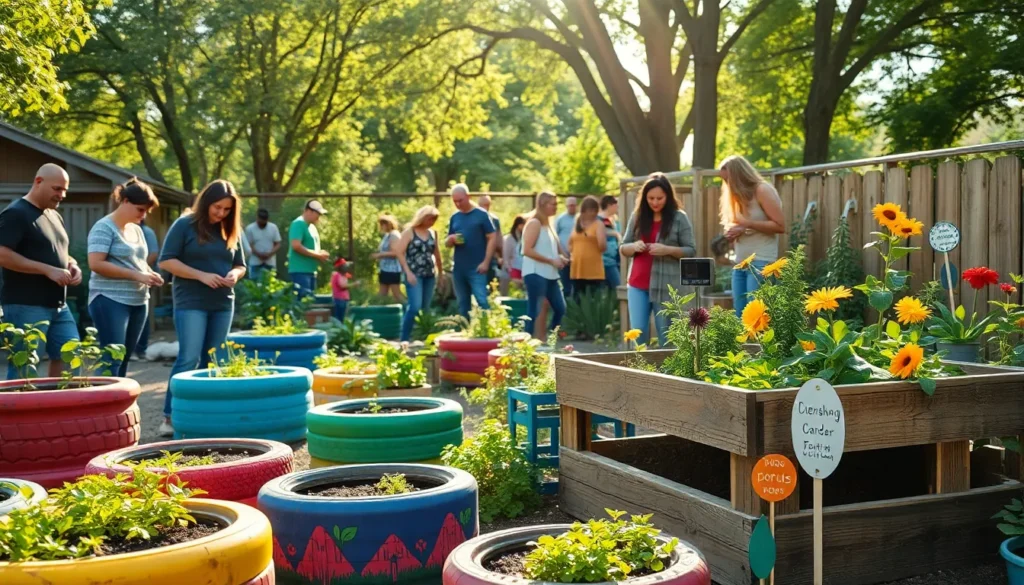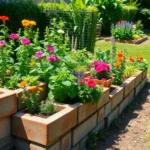We all dream of having a stunning garden that rivals those featured in home and garden magazines but our budgets don’t always match our ambitions. The good news? You don’t need to spend a fortune to create an outdoor oasis that’ll make your neighbors green with envy.
Transforming your outdoor space doesn’t require expensive landscaping services or high-end materials. With some creativity and elbow grease we can achieve remarkable results using everyday items and budget-friendly supplies from your local hardware store.
From repurposing household items into planters to creating eye-catching garden features with materials under $20 we’ve discovered that the most impressive gardens often come from the most resourceful minds. Let’s explore how to maximize your garden’s potential while keeping your wallet happy.
Transform Your Outdoor Space With Recycled Container Gardens
Container gardening transforms waste materials into stunning planters while keeping costs minimal. We’ll show you three budget-friendly approaches that turn everyday discarded items into thriving garden displays.
Repurpose Old Tires Into Colorful Planters
Painting old tires creates vibrant focal points that cost less than $15 per planter. We recommend using outdoor latex paint in bright colors like turquoise, coral, or sunny yellow to make your tire planters pop against green foliage.
Stack multiple tires vertically to create tower gardens perfect for herbs like basil, oregano, and thyme. This approach maximizes growing space in small yards while using materials that would otherwise end up in landfills.
Drill drainage holes every 6 inches around the bottom tire to prevent waterlogging. We’ve found that three quarter-inch holes work best for proper water flow without losing too much soil.
Add industry fabric inside each tire before filling with potting mix to keep soil contained while allowing water to drain freely. This simple step extends the life of your tire planters by several growing seasons.
Convert Plastic Bottles Into Hanging Gardens
Cut plastic bottles horizontally to create self-watering planters that require minimal maintenance. We use 2-liter soda bottles and gallon milk jugs most effectively for this project.
Thread cotton string through bottle caps to create a wicking system that draws water from the bottom reservoir to plant roots. This method keeps herbs and small vegetables consistently hydrated for up to a week.
Hang bottles from fence posts or porch railings using strong rope or chain to create vertical growing walls. We’ve successfully grown cherry tomatoes, lettuce, and strawberries using this space-saving technique.
Space hanging bottles 12 inches apart to allow adequate air circulation and prevent overcrowding. This spacing also makes harvesting easier while maintaining an attractive display.
Use Wooden Crates for Rustic Raised Beds
Source free wooden crates from local grocery stores, farmers markets, or shipping companies to build raised bed gardens at no cost. Apple crates and wine boxes work particularly well for this purpose.
Line crate bottoms with hardware cloth to keep burrowing pests out while allowing proper drainage. We attach the mesh using a staple gun for quick installation that lasts multiple seasons.
Stack crates two high to create deeper growing beds perfect for root vegetables like carrots, potatoes, and radishes. This height also reduces bending and makes garden maintenance more comfortable.
Fill crates with quality potting mix rather than garden soil to ensure proper drainage and nutrient content. We’ve found that a 50-50 blend of compost and peat moss creates excellent growing conditions for most vegetables and flowers.
Create Stunning Pathways Using Free Materials
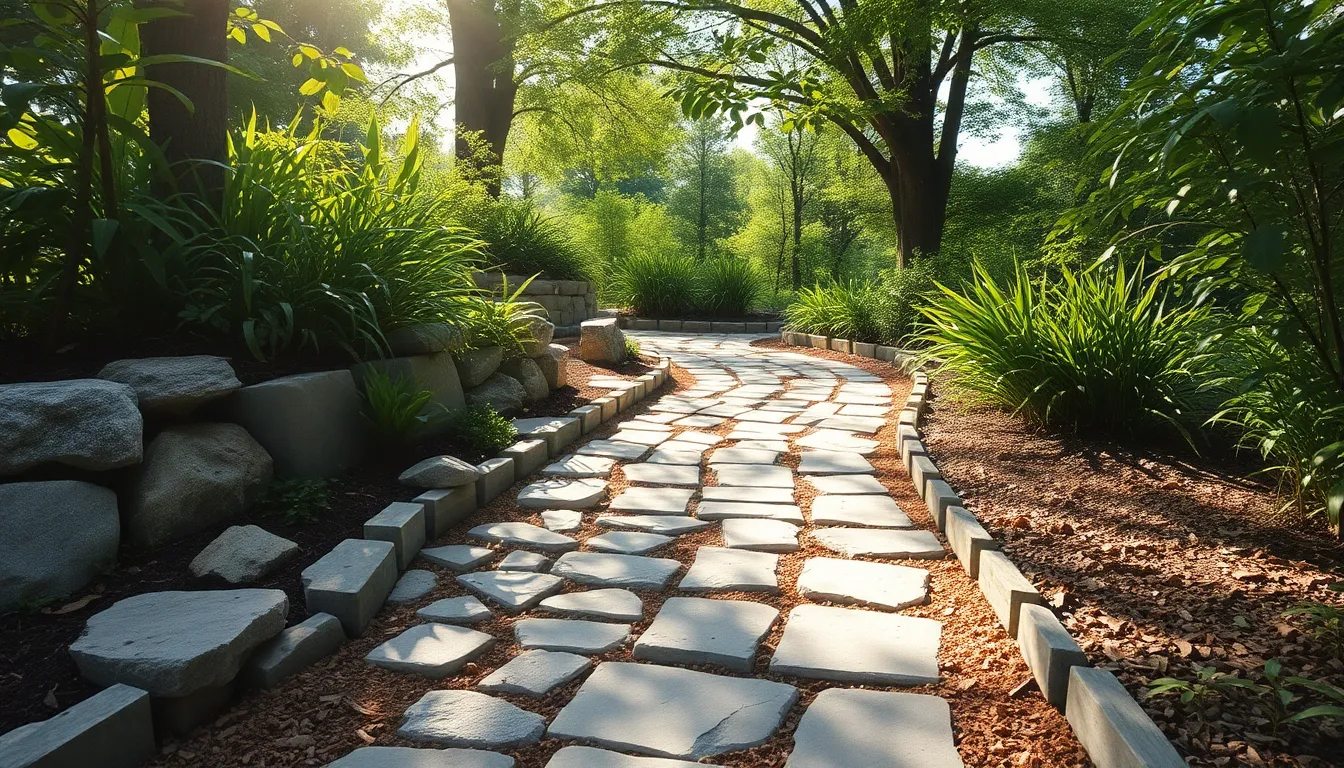
Garden pathways don’t require expensive materials to make a beautiful impact. We can transform our outdoor spaces using completely free resources that are readily available in most communities.
Design Gravel Walkways With Collected Stones
Gravel walkways represent one of the most affordable and easiest pathways to construct for our gardens. We can gather stones directly from our property or nearby areas instead of purchasing new gravel, then layer them over a simple weed barrier for longevity.
Benefits of collected stone pathways:
- Excellent drainage capabilities
- Minimal maintenance requirements
- Cost-effective construction
- Natural appearance
Salvaged wood or found materials work perfectly as edging to shape our walkway and provide stability. The natural stone texture creates visual interest while remaining functional for daily use.
Build Stepping Stone Paths From Broken Concrete
Broken concrete offers an excellent free resource for creating artistic stepping stone pathways. Demolition sites and community groups often provide this material at no cost, making it an ideal choice for budget-conscious gardeners.
Creating concrete stepping stone paths:
- Arrange large pieces in irregular patterns for artistic appeal
- Space stones based on foot traffic needs
- Fill gaps with gravel or ground covers for visual enhancement
- Position closer together for high-traffic areas
These repurposed concrete pieces provide a solid walking surface while adding unique character to our garden design. The weathered appearance of broken concrete creates an established, timeless look that complements various garden styles.
Create Mulch Trails Using Wood Chips
Wood chips create soft, natural pathways that work exceptionally well in wooded or shaded garden areas. Tree removal services and municipal programs typically provide this material for free, making it an accessible option for most homeowners.
Wood chip pathway advantages:
- Natural, organic appearance
- Soft walking surface
- Effective weed suppression
- Biodegradable material
We can spread wood chips directly on cleared soil for immediate results. Logs or rocks serve as excellent borders to define our mulch trails and prevent spreading. As the material naturally breaks down over time, we’ll need occasional replenishment to maintain the path’s appearance and functionality.
Build Budget-Friendly Garden Structures From Scratch
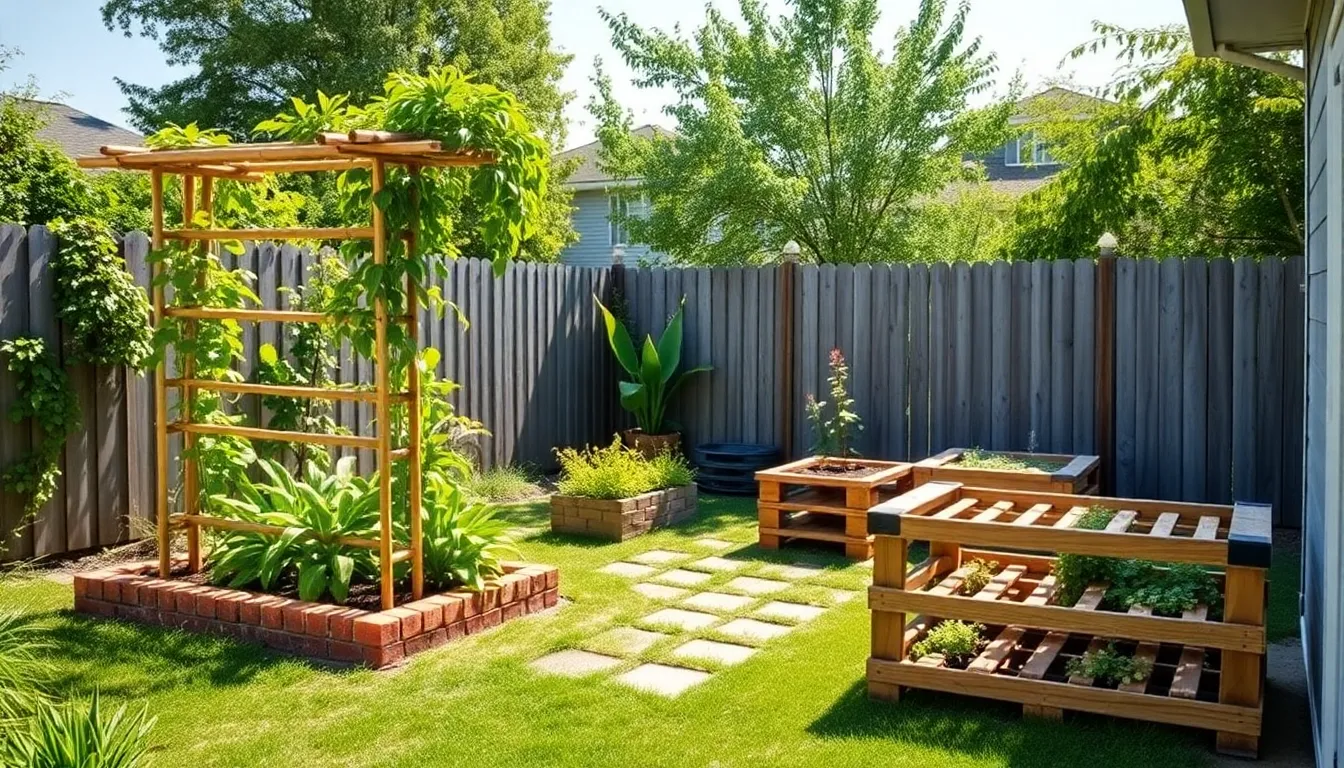
Creating functional garden structures doesn’t require professional carpentry skills or expensive materials. We can transform our outdoor spaces using readily available supplies and recycled items that cost significantly less than store bought alternatives.
Construct Simple Trellises With Bamboo Stakes
Bamboo stakes offer an inexpensive and durable solution for supporting climbing plants like peas, beans, cucumbers, and melons. We drive these stakes into the ground at regular intervals along our garden beds, then connect them using twine or wire to form grid patterns or teepee structures.
Benefits of bamboo trellises include:
- Strong support for heavy vining plants
- Maximized vertical growing space in small gardens
- No specialized tools required for assembly
- Adaptable designs for corner features or standalone supports
Assembly steps are straightforward:
- Space bamboo stakes 18-24 inches apart
- Drive stakes 6-8 inches deep into soil
- Tie horizontal supports with garden twine
- Create additional crossbeams for heavy crops
Make Garden Borders Using Recycled Bricks
Recycled bricks provide an attractive and permanent solution for defining garden spaces while preventing soil erosion and suppressing weeds. We can source these materials from construction sites or salvage yards at minimal cost, making them an excellent budget friendly option.
Installation process requires minimal preparation:
- Dig shallow trenches 2-3 inches deep along desired border lines
- Place bricks end to end in straight rows or creative patterns
- Pack soil firmly around each brick for stability
- Add sand between gaps for a finished appearance
Garden border benefits include:
- Durable materials that withstand weather conditions
- Clear definition between planted areas and pathways
- Reduced maintenance compared to temporary edging
- Customizable patterns for unique garden designs
Assemble Compost Bins From Wooden Pallets
Wooden pallets can be repurposed into efficient compost bins that contain organic waste while encouraging natural decomposition. We secure four pallets together at the corners to form square or rectangular enclosures, leaving one side accessible for adding materials and removing finished compost.
Construction requirements are minimal:
| Materials Needed | Tools Required | Assembly Time |
|---|---|---|
| 3-4 wooden pallets | Drill or hammer | 30-45 minutes |
| Wood screws or nails | Wire cutters | – |
| Wire mesh (optional) | Level | – |
Assembly benefits include:
- Cost effective alternative to purchased compost bins
- Customizable size based on available space
- Easy access for turning and harvesting compost
- Sturdy construction that lasts multiple seasons
We can reinforce these structures with additional wire mesh or extra pallets depending on our composting needs and available materials. These DIY compost bins efficiently process kitchen scraps and yard waste while reducing our gardening expenses.
Grow Your Own Plants to Save Money
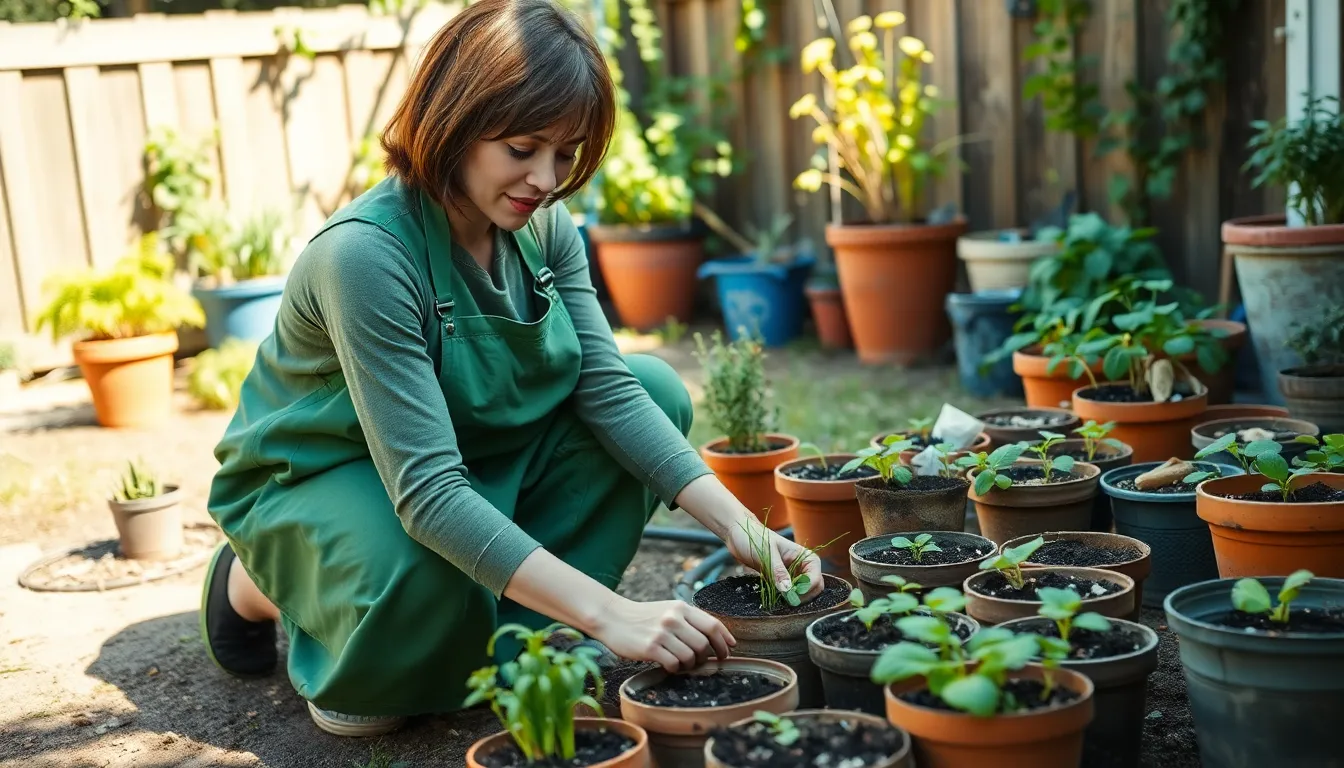
Growing your own plants from seeds and scraps represents one of the most effective ways to slash gardening expenses. We’ll explore three proven methods that can reduce plant costs by up to 90% compared to purchasing mature plants from nurseries.
Start Seeds Indoors Using Egg Cartons
Empty egg cartons transform into perfect mini greenhouses for starting seeds indoors at virtually no cost. We recommend cleaning the cartons thoroughly and poking drainage holes in each compartment’s bottom before filling them with seed starting mix.
Place one or two seeds in each compartment and keep the soil consistently moist using a spray bottle. Most seeds germinate within 1-2 weeks when placed in a warm location with indirect sunlight.
Transfer seedlings to larger pots once they develop their second set of true leaves, or plant them directly in the garden after the last frost. The cardboard egg cartons can be planted directly into the soil since they’ll decompose naturally over time.
Propagate Cuttings From Existing Plants
Taking cuttings from healthy plants allows us to multiply our garden collection without spending additional money on new purchases. Many common garden plants including pothos, coleus, mint, and geraniums root easily from 4-6 inch stem cuttings.
Cut stems just below a leaf node using clean scissors or pruning shears to prevent disease transmission. Remove lower leaves and place cuttings in water or moist potting soil, ensuring at least one node remains submerged.
Roots typically develop within 2-4 weeks depending on the plant variety and growing conditions. We’ve found that maintaining consistent moisture and providing bright indirect light produces the highest success rates for most cutting propagation projects.
Create a Herb Garden From Kitchen Scraps
Kitchen scraps offer an incredible opportunity to grow fresh herbs without purchasing seeds or plants from garden centers. Carrot tops, celery bases, green onions, and garlic cloves all regenerate when placed in water or soil.
Submerge the bottom inch of celery stalks or green onion bulbs in shallow water and change the water every 2-3 days to prevent bacterial growth. New growth appears within a week, and we can harvest fresh leaves continuously.
Plant garlic cloves pointed end up in well-draining soil during fall months for a summer harvest of full bulbs. Even herb stems from grocery store purchases can root in water, giving us endless supplies of basil, cilantro, and parsley throughout the growing season.
Design Eye-Catching Garden Features for Under $20
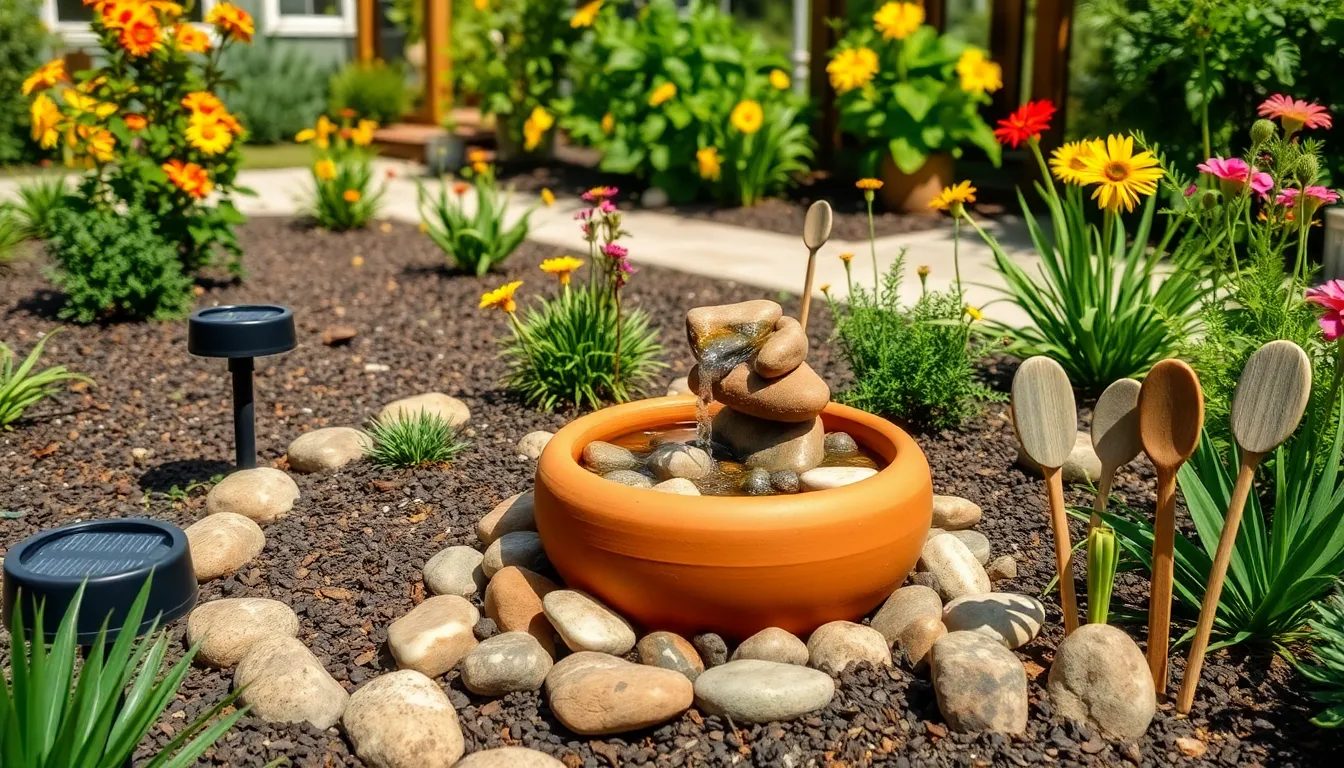
Creating stunning garden features doesn’t require a massive budget when you know which elements deliver maximum visual impact. We’ll explore three affordable projects that transform ordinary gardens into captivating outdoor spaces.
Install Solar Lights Along Garden Borders
Lighting transforms our garden’s nighttime appearance while costing just $10-$15 for a complete set of solar lights. We position these energy-efficient fixtures along garden paths and borders to create dramatic illumination that guides visitors through our outdoor space. Stakes push easily into soft soil, requiring no wiring or electrical expertise for installation.
Solar panels charge during daylight hours, automatically activating warm LED bulbs at dusk. We space lights approximately 6-8 feet apart for optimal coverage while avoiding over-illumination. Weather-resistant construction ensures these fixtures withstand rain, snow, and temperature fluctuations throughout the seasons.
Border lighting emphasizes our garden’s layout while adding safety benefits for evening navigation. We select warm white bulbs over cool white options to create a welcoming atmosphere that complements natural landscaping elements.
Build a Small Water Feature With Basic Supplies
Water features add soothing sounds and visual interest to our garden space for approximately $10-$20 in materials. We create mini fountains using small containers, basic pumps, and decorative rocks purchased from hardware stores. Large ceramic pots, plastic baskets, or repurposed containers serve as effective water basins.
Submersible pumps circulate water continuously, creating gentle bubbling sounds that mask traffic noise and attract beneficial wildlife. We position pumps at container bottoms, running tubing to surface-level spouts or decorative elements. River rocks or smooth pebbles hide mechanical components while adding natural texture.
Installation requires only basic assembly skills and access to outdoor electrical outlets for pump operation. We test water levels regularly and clean debris from pump intakes to maintain optimal performance. Small fountains consume minimal electricity while providing maximum sensory appeal.
Create Decorative Plant Markers From Household Items
Plant identification becomes an artistic element when we create custom markers from household materials at virtually no cost. We repurpose old stones, seashells, wooden spoons, and empty containers into unique garden labels that reflect our personal style. Smooth river rocks accept permanent marker ink or acrylic paint for weather-resistant plant names.
Empty yogurt containers transform into hanging tags when we punch holes and thread with garden twine. We write plant names with waterproof markers or use letter stickers for professional-looking results. Wooden popsicle sticks become elegant markers when painted with chalkboard paint for easy updates.
Creative markers help us track plant varieties while adding decorative elements throughout our garden beds. We position markers near plant bases or insert stakes into soil for elevated visibility. Weatherproof materials ensure our labels remain legible through multiple growing seasons without replacement costs.
Maximize Small Spaces With Vertical Growing Solutions
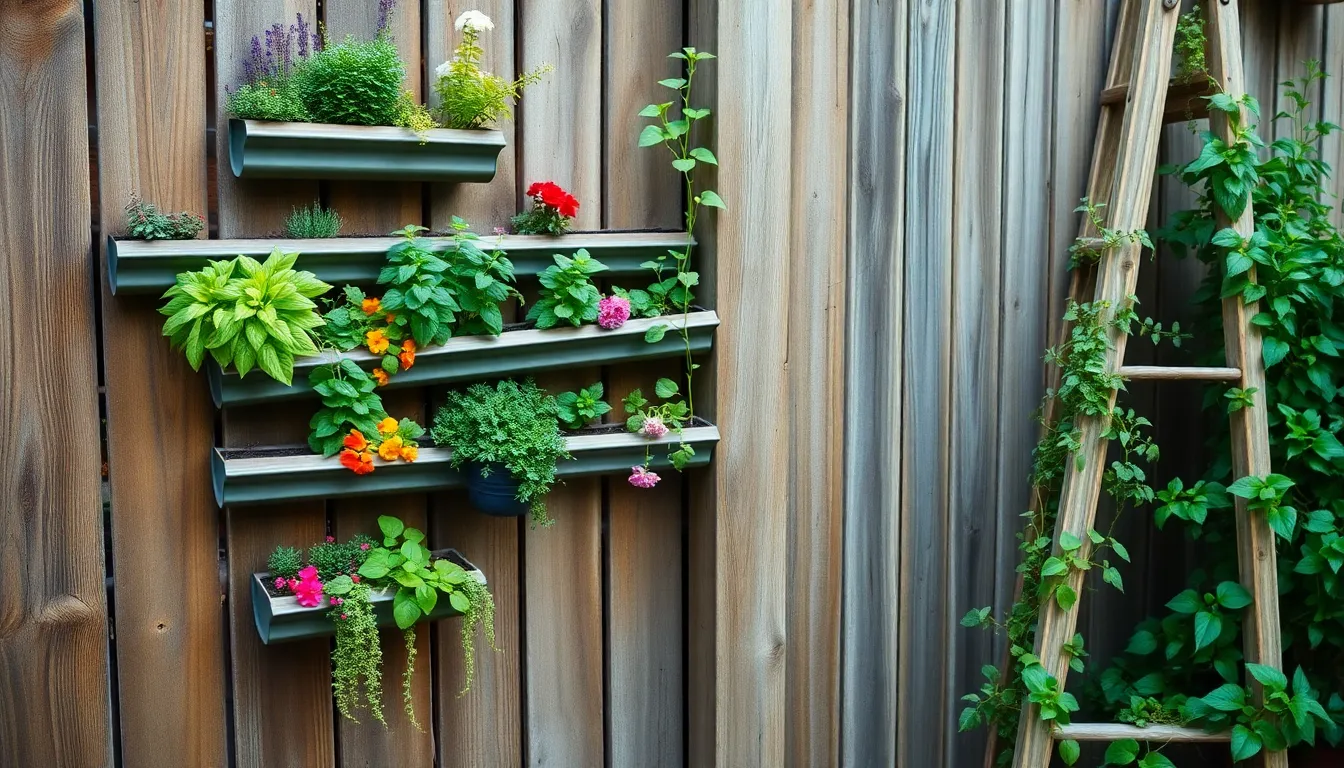
We can transform any cramped outdoor area into a productive garden paradise by growing upward instead of outward. Vertical gardening strategies help us maximize every square foot while keeping costs incredibly low.
Mount Wall Planters Using Repurposed Materials
Transform old gutters into thriving herb gardens by mounting them horizontally on walls or fences. These makeshift planters provide excellent drainage for lettuces, herbs, and flowers while keeping plants at eye level for easy harvesting.
Convert wooden crates and wine boxes into charming wall-mounted displays that add rustic character to bare surfaces. We simply drill drainage holes in the bottom and secure them with sturdy brackets to create instant growing space.
Repurpose dresser drawers as unique vertical planters that bring vintage appeal to our outdoor walls. Old furniture pieces work perfectly for this purpose since they’re already designed to hold weight and can accommodate deeper-rooted plants.
Build Ladder Gardens for Climbing Plants
Use old wooden or metal ladders as instant trellises for beans, peas, cucumbers, and decorative vines. We can lean them against walls or fences to create sturdy vertical supports that cost nothing if we already have unused ladders.
Paint ladders in bright colors to add personality while providing functional growing structures. This simple customization transforms discarded items into attractive garden features that support climbing plants beautifully.
Position ladders strategically to allow planting on both sides, which doubles our growing capacity while improving air circulation around plants. Multiple ladders can create impressive vertical displays in corners or along fence lines.
Install Gutter Gardens on Fences or Walls
Mount vinyl gutters horizontally at different heights to create cascading garden displays that maximize wall space efficiently. We can find inexpensive gutters at hardware stores or repurpose old ones from home renovations.
Fill gutters with lightweight potting soil and plant aromatic herbs like basil, mint, and cilantro for easy kitchen access. These narrow planters work perfectly for shallow-rooted plants and prevent soil from becoming waterlogged.
Secure gutters with sturdy brackets spaced every 2-3 feet to prevent sagging under the weight of soil and plants. Proper installation ensures our gutter gardens remain stable throughout growing seasons while providing continuous harvests.
Maintain Your Garden Naturally Without Expensive Products
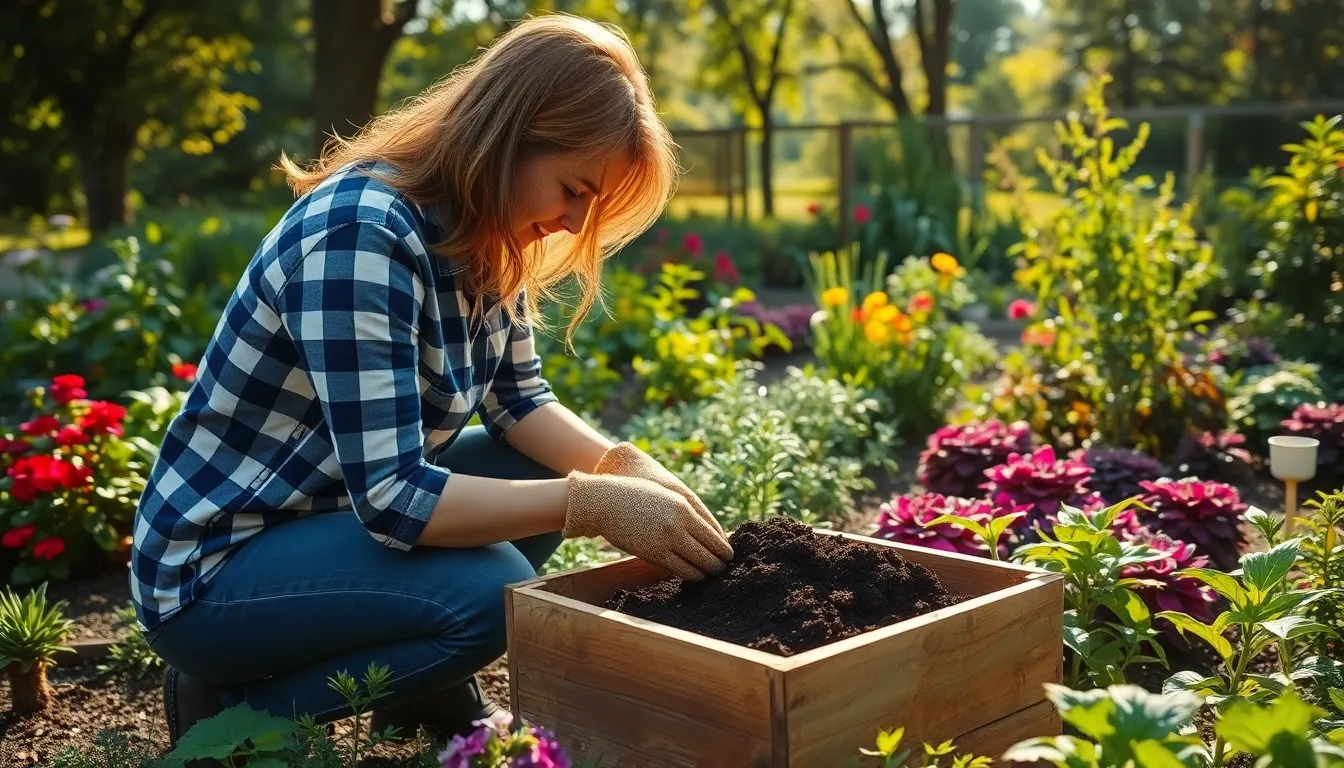
Building on our budget-friendly garden structures and plant growing strategies, we can extend these cost-saving principles to garden maintenance. Natural maintenance methods eliminate the need for expensive commercial products while creating healthier garden ecosystems.
Make Homemade Fertilizer From Kitchen Waste
Composting kitchen scraps transforms everyday waste into nutrient-rich soil amendments. Vegetable peels provide essential minerals while coffee grounds add nitrogen content that plants crave. Eggshells contribute calcium and help balance soil pH naturally.
Start your compost pile by layering organic materials in a simple bin or designated garden area. Brown materials like dried leaves and paper create structure while green materials such as fruit scraps and grass clippings provide nitrogen. Turn the pile weekly to accelerate decomposition and prevent odors.
Create liquid fertilizer by steeping compost in water for several days. This “compost tea” delivers nutrients directly to plant roots when applied during watering. Banana peels steeped in water release potassium that flowering plants especially benefit from.
Create Natural Pest Control Answers
Garlic spray repels aphids and soft-bodied insects without harming beneficial garden visitors. Blend three garlic cloves with two cups of water and strain the mixture into a spray bottle. Apply this solution directly to affected plant leaves during early morning or evening hours.
Insecticidal soap made from dish soap and water controls spider mites and whiteflies effectively. Mix one tablespoon of mild dish soap with one quart of water for a gentle pest deterrent. Test the solution on a small plant area first to ensure your plants won’t experience leaf burn.
Companion planting with herbs like basil and marigold naturally deters harmful insects. Basil planted near tomatoes repels hornworms while marigolds emit scents that discourage aphids and nematodes. These plants serve dual purposes by providing harvests and natural pest protection.
Use Coffee Grounds and Eggshells as Soil Amendments
Coffee grounds improve soil texture while adding nitrogen content that promotes healthy plant growth. Sprinkle used grounds directly around acid-loving plants like blueberries and azaleas. Mix grounds with existing compost to prevent them from forming impermeable layers in garden beds.
Crushed eggshells provide calcium that prevents blossom end rot in tomatoes and peppers. Rinse shells thoroughly and crush them into small pieces before working them into planting holes. This slow-release calcium source strengthens cell walls and improves fruit development.
Both materials condition heavy clay soils by improving drainage and aeration. Coffee grounds break up compacted soil while eggshells add structure that allows water and air to penetrate more easily. Apply these amendments in thin layers and work them into the top few inches of soil.
Conclusion
Transforming your outdoor space doesn’t require a massive budget or professional landscaping services. We’ve shown you that with creativity and resourcefulness you can build stunning garden features using everyday materials and household items.
From repurposed containers and vertical growing answers to natural maintenance methods these DIY approaches prove that beautiful gardens are accessible to everyone. The key lies in seeing potential in ordinary objects and thinking outside traditional gardening boundaries.
Start with one simple project that excites you most whether it’s creating a stepping stone pathway or building your first trellis. As you gain confidence you’ll discover even more ways to enhance your garden while keeping costs minimal and embracing sustainable practices.
Frequently Asked Questions
Can I create a beautiful garden without spending a lot of money?
Absolutely! You don’t need expensive landscaping services or high-end materials. With creativity and resourcefulness, you can transform your outdoor space using everyday items, recycled materials, and affordable supplies from local hardware stores. The key is to repurpose household items and think outside the box.
What are some budget-friendly container gardening ideas?
You can create stunning container gardens using recycled materials like old tires (painted for colorful planters), plastic bottles (converted into self-watering hanging gardens), and wooden crates (transformed into rustic raised beds). These methods cost very little and promote environmental sustainability.
How can I make garden pathways without spending much money?
Use free or low-cost materials like collected stones for gravel walkways, broken concrete pieces for stepping stone paths, or wood chips for mulch trails. These materials often provide excellent drainage, require minimal maintenance, and create natural-looking pathways.
What garden structures can I build on a tight budget?
Simple structures include bamboo trellises for climbing plants, garden borders using recycled bricks, and compost bins made from wooden pallets. These DIY projects require minimal investment while providing functional garden features that enhance your outdoor space.
How can I save money on plants and seeds?
Grow plants from seeds using empty egg cartons as mini greenhouses, propagate cuttings from existing plants, and regenerate kitchen scraps like green onions and herbs. These methods can reduce plant costs by up to 90% compared to buying mature plants.
What garden features can I create for under $20?
Install solar lights for evening ambiance, build small water features using basic containers and pumps, or create decorative plant markers from household items like painted stones or wooden spoons. These projects add charm without breaking your budget.
How can I maximize small garden spaces affordably?
Use vertical gardening solutions like transforming old gutters into wall-mounted herb gardens, repurposing wooden crates as vertical planters, or using old ladders as trellises. These approaches optimize growing capacity while keeping costs low.
Can I maintain my garden naturally without expensive products?
Yes! Make homemade fertilizers from kitchen waste like vegetable peels and coffee grounds, create natural pest control solutions using garlic spray or insecticidal soap, and use companion planting to deter harmful insects naturally.

